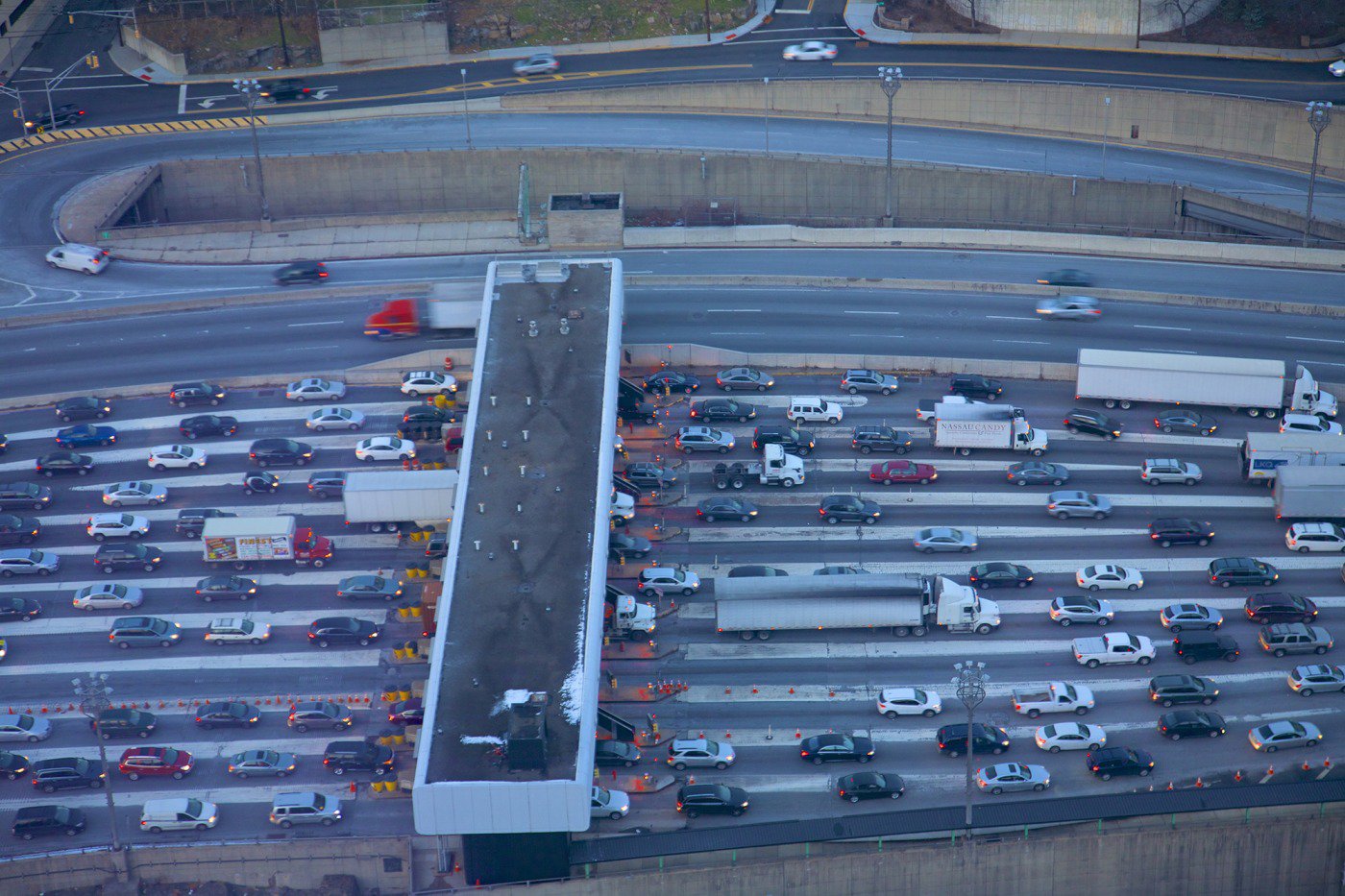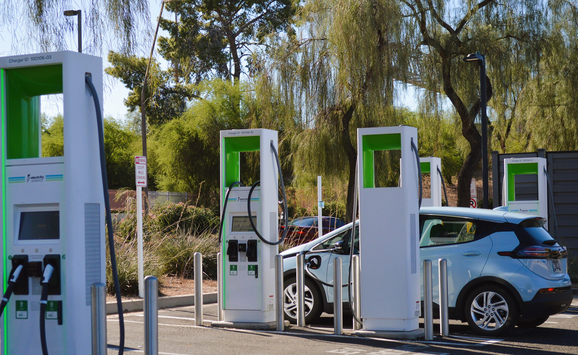To reduce road congestion, Republicans propose delegating the repair, expansion, and construction of roads to private firms, to be financed by private tolls. But motorists would be better off if congestion tolls were instead set by the government.

Americans’ love affair with their cars and the open road is not a new story. But in a nation built around an interstate highway system once touted as among the best in the world, neither is the problem of crumbling infrastructure. The American Society of Civil Engineers (ASCE) gave our nation’s roads a grade of D on its 2017 infrastructure report card—the same dismal grade as in its last assessment from 2013. This state of disrepair has widespread implications. According to the ASCE, “more than two out of every five miles of America’s urban interstates are congested,” and American drivers spent an average of 42 hours delayed in traffic in 2014—6.9 billion hours total—costing the country $160 billion in wasted time and fuel that year alone.
Rectifying this situation is worth many times the cost. For each dollar spent improving American roads, highways, and bridges, the Federal Highway Administration estimates that related costs would be reduced by $5.20. But the challenge is more complex than tallying the numbers and further complicated by differing political ideologies.

Republicans propose to reduce road congestion by delegating the repair and expansion of existing roads as well as the construction of new roads to private firms. In return, these firms would be given the right to set tolls on these roads and use the toll revenue to defray their expenses. Democrats have criticized this proposal on distributive grounds. As Senate Minority Leader Chuck Schumer (D-NY) observed in January: “You won’t build many roads. And the ones you will [build] have such large tolls that the very middle-class people that Donald Trump has said he wants to help will be dramatically hurt.”
But there is a more fundamental objection to the Republican “solution” to America’s congestion problem—it disregards how tolls affect congestion. Former Transportation Secretary Anthony Foxx remarked on this in an interview with the Associated Press, noting “You could put $5 trillion into America’s transportation system and if the money isn’t directed in the right way, we will still have congestion, still have problems.”
Framing the Problem: Insights from Economic Theory
In the 1920s, economists A.C. Pigou and Frank Knight waged a now-famous academic debate about how access tolls affect the use of congestible resources and who should set these tolls and collect the revenue. Back then, congestible resources included roads, bridges, fishing grounds, and pastures; now, airports, the Internet, and the radio frequency spectrum should be added to the list.
The Republican “solution” to America’s congestion problem disregards how tolls affect congestion.
Author
Pigou worked out what road tolls the government should set to minimize time wasted (and therefore wages lost) commuting—essentially taxing each motorist for the cost (in terms of lost wages) that his entry to the roadway imposes on other motorists. In response, Knight argued that if there was one congestible road and the private sector was allowed to set the toll, it would charge the same toll as Pigou had recommended that the government charge—because if it set a higher toll, the increased revenue gained from those using the road would be offset by the loss in revenue from motorists who switch to an alternative road.
Thus, it seemed to be merely a matter of assigning to a profit-maximizing firm the “property right” to restrict access to motorists paying a toll of the firm’s choosing—there was no need for government meddling. In reaching his conclusion, Knight assumed the existence of a single fast but congestible toll road competing against a slower but uncongestible free alternative. In an apparent capitulation, Pigou dropped discussion of road congestion from later editions of his textbook. Others revisited this debate in subsequent literature but—because these reconsiderations preceded the advent of modern oligopoly theory—always in the context of a single (monopolist) toll-setter.
More recently, Harold Demsetz argued that Knight’s result continues to hold when there are two congestible roads leading from the same origin to the same destination, each with its own toll-setter. According to Demsetz, even in this setting with duopoly toll-setters and no free uncongestible road, “Knight’s private roads…would result in an optimal amount of congestion.”
Reconsidering the Debate and Expanding its Focus
Unlike the previous literature, we consider in recent research toll-setting oligopolies of any size (that is, two or more congestible roads, each with its own toll-setter) and an uncongestible road of any speed. Since our treatment is more general, it covers more cases of practical interest. Knight’s framework applies in the case of simple commutes. For example, travel from Carpinteria, California, to Santa Barbara, where there are only two choices—the slow but uncongestible Amtrak train and the fast but congestible freeway (US 101). But it is inapplicable for commutes between northern New Jersey and midtown Manhattan, for example, where one must choose among one of several bridges or tunnels if commuting by car or, in the absence of a car, between a train and a ferry. As in the rest of the economics literature, we assume that commuters choose the least costly route to work, taking into account not only tolls but also the time cost of commuting.

Our study shows that private toll-setting rarely minimizes overall time lost commuting and when it does, the tolls charged are higher than what Pigou recommended. In rural areas, where there are no uncongestible alternatives such as trains or subways (such as in Demsetz’s case), this finding suggests that tolls set by the private sector are likely to result in unnecessarily long commutes. We also show that—except in the case of an especially fast uncongestible road—the earnings motorists take home after paying tolls will be strictly higher if the government sets Pigouvian tolls instead of leaving motorists at the mercy of private sector.
Evaluating Policy Options: Today’s Reality
Proponents of private tolls often cite the need to pay for investments to improve roads. This issue, despite its practical importance, was neglected in the 1920s debate and in the subsequent theoretical literature. We demonstrate the superiority of government toll-setting from this perspective as well. Specifically, we outline how the government could add a common amount to each Pigouvian toll in a way that keeps motorists better off than they would be with tolls set by the private sector, minimizes aggregate hours wasted commuting, and brings in higher revenues than private toll-setters would generate.
Private toll-setting rarely minimizes time lost commuting and when it does, tolls are higher.
Author
Policy design and related transportation investments must be carefully considered—as former Transportation Secretary Foxx pointed out, not all investment in new roads will decrease congestion. The academic literature has noted two such paradoxes. The first, the Downs-Knight-Pigou paradox, shows that adding another fast but congestible road will not improve commute times at all if, after it is built, some motorists still choose to use the slow, uncongestible road. In this case, if some motorists still use the uncongestible road, the new road must have slowed so much due to congestion that commute time on the new road is now just as slow—in other words, no one’s commute time improves. Braess’s paradox goes a step further, showing that adding another road—even if it is extremely fast and uncongestible—can, in fact, increase the time wasted getting to the destination if the attraction of the new road causes sufficiently greater congestion on the roads required to access it.
Our research presents a paradox of its own but (unlike those noted above) it concerns roads with tolls set by the private sector. We demonstrate that unless the uncongestible road is sufficiently fast, an additional toll road will not benefit motorists. Both before and after the addition of the new road, private toll-setters will charge motorists as much as they can without inducing switches to the uncongestible road—a phenomenon known as “limit pricing.” Because the speed of the uncongestible road remains the same when the new toll road is added, the full cost motorists pay in terms of foregone wages and tolls will remain the same. Motorists will get to work faster than before and therefore will have higher take-home pay—but all their extra earnings will go to pay the higher tolls.
If, despite all these reasons for leaving toll-setting under government control, private toll-setting is still embraced by Congress, we propose that the government provide a “public option”—for example, a train traversing the same route. The availability of this alternative would implicitly regulate private toll-setting—lowering the full cost to motorists and raising their overall earnings (after the deduction of toll payments). Needless to say, private toll-setters should be expected to lobby hard against such public options.








